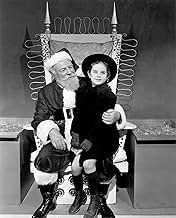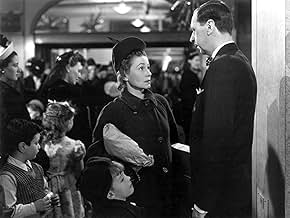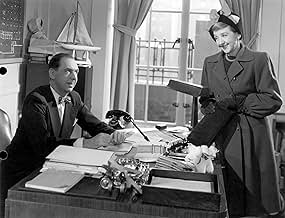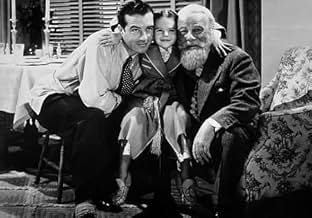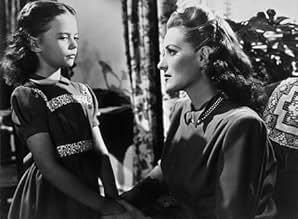CALIFICACIÓN DE IMDb
7.9/10
58 k
TU CALIFICACIÓN
Cuando un buen anciano que dice ser Papá Noel es institucionalizado como loco, un joven abogado decide defenderlo argumentando en la justicia que él es el verdadero.Cuando un buen anciano que dice ser Papá Noel es institucionalizado como loco, un joven abogado decide defenderlo argumentando en la justicia que él es el verdadero.Cuando un buen anciano que dice ser Papá Noel es institucionalizado como loco, un joven abogado decide defenderlo argumentando en la justicia que él es el verdadero.
- Dirección
- Guionistas
- Elenco
- Ganó 3 premios Óscar
- 10 premios ganados y 1 nominación en total
Jack Albertson
- Post Office Mail Sorter Next to Lou
- (sin créditos)
Harry Antrim
- Mr. R.H. Macy
- (sin créditos)
Arline Bletcher
- Courtroom Spectator
- (sin créditos)
Lela Bliss
- Mrs. Shellhammer
- (sin créditos)
Symona Boniface
- Courtroom Spectator
- (sin créditos)
Walden Boyle
- Judge's Clerk
- (sin créditos)
Kevin Burke
- Child on Santa's Lap
- (sin créditos)
Dorothy Christy
- Secretary
- (sin créditos)
Dick Cogan
- Department Store Head
- (sin créditos)
- Dirección
- Guionistas
- Todo el elenco y el equipo
- Producción, taquilla y más en IMDbPro
Opiniones destacadas
The remakes just don't carry the magic of the original, and what a cast we find in the original, starting with the beautiful Maureen O'Hara and the (then) child star Natalie Wood. Edmund Gwinn is perfect as Santa Claus, who appears on the scene when the Macy's Santa shows up drunk for the Thanksgiving Day Parade.
There are dozens of small comedic touches in the film, such as Santa sending customers to other stores when Macy's doesn't have what they need, and then the rivalry between Macy's and Gimball's when they copy the tactic.
Of course, the big payoff is the courtroom scenes, which just get funnier and funnier. This is one of the true Christmas Classics. Watch and enjoy. :-)
There are dozens of small comedic touches in the film, such as Santa sending customers to other stores when Macy's doesn't have what they need, and then the rivalry between Macy's and Gimball's when they copy the tactic.
Of course, the big payoff is the courtroom scenes, which just get funnier and funnier. This is one of the true Christmas Classics. Watch and enjoy. :-)
What's wonderful about 'Miracle On 34th Street (1947)' - and this isn't something I realised until after it had finished - is that it never actually provides a definitive answer as to whether Kris Kringle really is the Santa Claus. Personally, I took it as fact from the moment he walked into frame, but I'm pretty sure that was due to my preconceptions surrounding the plot of the picture (Santa goes to court to prove his existence). Thinking back, I had no definitive reason to think that. The absolute ambiguity of the film's central dilemma is brilliant because it forces the viewer to engage with the question that's on almost every characters' lips: is this the real Santa or is it just a kind old man who thinks he's the real Santa? In turn, this allows the movie's theme of belief to transcend its boundaries and truly take root in the audience. Whether you choose to believe in Santa, whether you choose to have faith in him, whether you choose to accept the unacceptable is entirely up to you. As such, it's that much more magical if you do. It's really impressive that the picture can actually use its ambiguity to this effect, especially that it can do so while remaining wholesome and sincere throughout. This charming Christmas tale is enjoyable from beginning to end and it holds up remarkably well seventy-five years after its initial release. It's a delightful experience overall.
There's a "legend" connected with this film, one which has recently gained new life via AMC: Supposedly, upon completion of principle filmmaking, 1947's "Miracle On 34th Street" then had to be submitted to the heads of Macy's and Gimble's department stores who -- had either man withheld approval -- could have cost 20th Century Fox a small fortune in rewrites and reshootings.
Frankly, in view of the fact that much of "Miracle" had already been shot on location in Macy's New York City store (to say nothing of the fact that studio heads of that era -- or any era, for that matter -- were notoriously prone not to take such financial risks), this "legend" is likely just so much "hype," otherwise known as "nonsense."
Thankfully, this is the only trace of phoniness attached to this jewel of a movie. "Miracle On 34th Street" is just that, in every sense of the word: a miracle.
Take a perfectly-crafted, thoughtful screenplay. Add an impeccable cast (from top-to-bottom, by the way; catch, just as one example, Thelma Ritter's uncredited turn as "Peter's Mother"). Throw into this mix an on-location "shoot" (along with Macy's, there's the store's actual 1946 Thanksgiving Parade, footage in a post office facility and a courthouse) which gives this film a nice sense of verisimilitude . . . just in case you're not already prepared (courtesy of Edmund Gwenn, in a totally-deserved Oscar-winning performance) to recapture your belief in Santa Claus.
"Miracle On 34th Street" is many things: a celebration of the Christmas spirit, a heartfelt plea against the "over-commercialism" (even in 1947)of Christmas, an examination of faith itself . . . just to name a few.
It works on every level. Every bit as well today, 54 years after its initial release, as then. Don't waste your time with the remakes -- both on TV as well as theatrical productions (and the less said about an abortive 1963 Broadway musical adaptation, "Here's Love," the better.)
Go for the original film. Go for the genuine article. Again and again and again.
Frankly, in view of the fact that much of "Miracle" had already been shot on location in Macy's New York City store (to say nothing of the fact that studio heads of that era -- or any era, for that matter -- were notoriously prone not to take such financial risks), this "legend" is likely just so much "hype," otherwise known as "nonsense."
Thankfully, this is the only trace of phoniness attached to this jewel of a movie. "Miracle On 34th Street" is just that, in every sense of the word: a miracle.
Take a perfectly-crafted, thoughtful screenplay. Add an impeccable cast (from top-to-bottom, by the way; catch, just as one example, Thelma Ritter's uncredited turn as "Peter's Mother"). Throw into this mix an on-location "shoot" (along with Macy's, there's the store's actual 1946 Thanksgiving Parade, footage in a post office facility and a courthouse) which gives this film a nice sense of verisimilitude . . . just in case you're not already prepared (courtesy of Edmund Gwenn, in a totally-deserved Oscar-winning performance) to recapture your belief in Santa Claus.
"Miracle On 34th Street" is many things: a celebration of the Christmas spirit, a heartfelt plea against the "over-commercialism" (even in 1947)of Christmas, an examination of faith itself . . . just to name a few.
It works on every level. Every bit as well today, 54 years after its initial release, as then. Don't waste your time with the remakes -- both on TV as well as theatrical productions (and the less said about an abortive 1963 Broadway musical adaptation, "Here's Love," the better.)
Go for the original film. Go for the genuine article. Again and again and again.
This is certainly a lovely warmhearted movie, but since other reviewers have described the plot in detail, I'll move on to other topics.
I love movies like this for the insight they provide into the customs of a lost era. Watch the clothing - everybody is so dressed up! - women in dresses, gloves, and hats, men in hats and suits. Notice that when O'Hara enters a room filled with Macy's executives, even though they are the bosses and she is lower management, they all stand up instantly.
The social satire, most on display in the courtroom scenes, also is very 1940s. Apparently audiences of that era took a kind of genial corruption in the judicial system in stride. Business leaders, like "Mr. Macy" were expected to be sharp and profit-oriented, but also decent people like the rest of us. It's a much more nuanced view than the "businessman as criminal villain" so common in today's movies.
The character played by Maureen O'Hara probably needs explanation for modern viewers. Late 1940s audiences knew that the social and economic situation of a divorced working woman with a child was much more precarious than it is now. Divorce was still somewhat shocking - this is brought out neatly in the movie when her would-be lover does a double take when he learns from her daughter about the divorce - he probably had assumed she was a war widow. Divorced moms were still rare in the middle classes. Society universally agreed that women should stay home to raise their children. Economically, women in management positions were still very rare, couldn't expect promotion, and were last hired, first fired. I think O'Hara's performance brings out these qualities in a way that the audience of the 1940s would have understood easily. The character's stiffness, fear of losing control, and anxiety about her job make a great deal of sense. It would have been nice to see a few scenes showing her loosening up, perhaps at dinner with her boyfriend; no doubt those got left on the cutting room floor.
I really like the scene where Santa talks to the little Dutch orphan. First, this scene also must have resonated with the audience; in 1947 the western European countries had only started to recover from World War II, and probably many Americans were familiar with the idea of adopting a war orphan, just as many sent CARE packages. Second, by making Santa fluent in Dutch, the writer cleverly left the viewer thinking that hey, he might really be Santa Claus (isn't Santa Claus fluent in all languages)?
Some reviewers don't like the acting and think that modern actors are "better". I think the older actors aren't better or worse, just different. The audiences of the 1940s expected a certain style of acting, and the directors and actors gave that to them. Then as now, Hollywood paid top dollar and got very talented people, but like all of us they were shaped by their own time and place, more particularly the requirement to make movies that audiences would like. Move Maureen O'Hara to 2004, or Tom Cruise to 1947, and you'd see them acting in the style of that decade.
I love movies like this for the insight they provide into the customs of a lost era. Watch the clothing - everybody is so dressed up! - women in dresses, gloves, and hats, men in hats and suits. Notice that when O'Hara enters a room filled with Macy's executives, even though they are the bosses and she is lower management, they all stand up instantly.
The social satire, most on display in the courtroom scenes, also is very 1940s. Apparently audiences of that era took a kind of genial corruption in the judicial system in stride. Business leaders, like "Mr. Macy" were expected to be sharp and profit-oriented, but also decent people like the rest of us. It's a much more nuanced view than the "businessman as criminal villain" so common in today's movies.
The character played by Maureen O'Hara probably needs explanation for modern viewers. Late 1940s audiences knew that the social and economic situation of a divorced working woman with a child was much more precarious than it is now. Divorce was still somewhat shocking - this is brought out neatly in the movie when her would-be lover does a double take when he learns from her daughter about the divorce - he probably had assumed she was a war widow. Divorced moms were still rare in the middle classes. Society universally agreed that women should stay home to raise their children. Economically, women in management positions were still very rare, couldn't expect promotion, and were last hired, first fired. I think O'Hara's performance brings out these qualities in a way that the audience of the 1940s would have understood easily. The character's stiffness, fear of losing control, and anxiety about her job make a great deal of sense. It would have been nice to see a few scenes showing her loosening up, perhaps at dinner with her boyfriend; no doubt those got left on the cutting room floor.
I really like the scene where Santa talks to the little Dutch orphan. First, this scene also must have resonated with the audience; in 1947 the western European countries had only started to recover from World War II, and probably many Americans were familiar with the idea of adopting a war orphan, just as many sent CARE packages. Second, by making Santa fluent in Dutch, the writer cleverly left the viewer thinking that hey, he might really be Santa Claus (isn't Santa Claus fluent in all languages)?
Some reviewers don't like the acting and think that modern actors are "better". I think the older actors aren't better or worse, just different. The audiences of the 1940s expected a certain style of acting, and the directors and actors gave that to them. Then as now, Hollywood paid top dollar and got very talented people, but like all of us they were shaped by their own time and place, more particularly the requirement to make movies that audiences would like. Move Maureen O'Hara to 2004, or Tom Cruise to 1947, and you'd see them acting in the style of that decade.
Still among the most worthwhile of the familiar holiday movies, this classic version of "Miracle on 34th Street" has a combination of cast, story, and production that works well. Maureen O'Hara, young Natalie Wood, and Edmund Gwenn would probably have carried it pretty well by themselves, and they are joined by a very good supporting cast. The screenplay is nicely done, bringing out the fantasy elements of the story without letting it become trite.
Gwenn, who played many solid character roles, gets the chance here to play a role for which he was ideally suited, and it works very well. O'Hara and Wood make a good pair to balance him out. The supporting cast gets some very good moments of their own, especially Gene Lockhart and William Frawley, whose scenes are entertaining while also offering some occasionally pointed commentary.
The style of the production is well-suited to the material, offering an innocently upbeat story without overdoing it on sentimentality. For all that this style of the production and acting are out of fashion, they are able to capture a theme like this in a worthwhile way that is simply not possible with the kind of false "sophistication" that permeates so many present-day movies.
That's not to say that this is some kind of masterpiece, which it is not and did not try to be. Instead, it's a light, enjoyable, positive movie that does make a worthwhile point or two. That kind of feature will always find an appreciative audience somewhere.
Gwenn, who played many solid character roles, gets the chance here to play a role for which he was ideally suited, and it works very well. O'Hara and Wood make a good pair to balance him out. The supporting cast gets some very good moments of their own, especially Gene Lockhart and William Frawley, whose scenes are entertaining while also offering some occasionally pointed commentary.
The style of the production is well-suited to the material, offering an innocently upbeat story without overdoing it on sentimentality. For all that this style of the production and acting are out of fashion, they are able to capture a theme like this in a worthwhile way that is simply not possible with the kind of false "sophistication" that permeates so many present-day movies.
That's not to say that this is some kind of masterpiece, which it is not and did not try to be. Instead, it's a light, enjoyable, positive movie that does make a worthwhile point or two. That kind of feature will always find an appreciative audience somewhere.
¿Sabías que…?
- TriviaIn the untranslated dialogue with the Dutch girl, Kris asks her what she wants for Christmas. She says she wants nothing, telling him she got her gift by being adopted by her new mother.
- ErroresKris claims that John Quincy Adams' Vice-President was Daniel D. Tompkins; actually, it was John C. Calhoun. Tompkins served under James Monroe from 1817-1825. The confusion likely occurred because Adams was the 6th President, whereas Tompkins was the 6th Vice-President, as Thomas Jefferson and James Madison had three Vice-Presidents between them.
- Citas
Mr. Shellhammer: But... but maybe he's only a little crazy like painters or composers or... or some of those men in Washington.
- Créditos curiososThe film's credits do not contain the standard "All characters and events are fictional..." disclaimer, leaving many people to believe that this was a true story.
- Versiones alternativasAlso available in two computer colorized versions. The film was first colorized in 1985 by Color Systems Technology, Inc. and again in 2006 by Legend Films using much-improved technology. Prints came with a disclaimer: "It has been altered without the participation of the principal director, screenwriter and other creators of the original film."
- ConexionesFeatured in The Screen Writer (1950)
- Bandas sonorasJingle Bells
(1857) (uncredited)
Written by James Pierpont
Played at the announcement of the parade
Played occasionally in the score
Sung a cappella a bit by Percy Helton and later by Jack Albertson
Selecciones populares
Inicia sesión para calificar y agrega a la lista de videos para obtener recomendaciones personalizadas
- How long is Miracle on 34th Street?Con tecnología de Alexa
- Why is the clown at the Macy's parade not listed anywhere in the cast list? He has the memorable line: "These pants are going to fall off in the middle of Columbus Circle."
- What is 'Miracle on 34th Street' about?
- Is 'Miracle on 34th Street' based on a book?
Detalles
- Fecha de lanzamiento
- País de origen
- Idiomas
- También se conoce como
- Milagro en la calle 34
- Locaciones de filmación
- 24 Derby Road, Port Washington, Long Island, Nueva York, Estados Unidos(Susan's dream house)
- Productora
- Ver más créditos de la compañía en IMDbPro
Taquilla
- Total a nivel mundial
- USD 3,851
- Tiempo de ejecución1 hora 36 minutos
- Color
- Relación de aspecto
- 1.37 : 1
Contribuir a esta página
Sugiere una edición o agrega el contenido que falta

Principales brechas de datos
What is the Hindi language plot outline for De ilusión también se vive (1947)?
Responda





